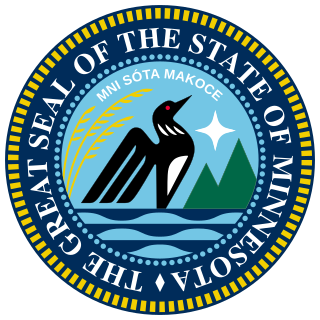Top Qs
Timeline
Chat
Perspective
Minnesota Senate
Upper house of the Minnesota legislature From Wikipedia, the free encyclopedia
Remove ads
The Minnesota Senate is the upper house of the legislature of the U.S. state of Minnesota. At 67 members, half as many as the Minnesota House of Representatives, it is the largest upper house of any U.S. state legislature.[2] Floor sessions are held in the west wing of the State Capitol in Saint Paul. Committee hearings, as well as offices for senators and staff, are located north of the State Capitol in the Minnesota Senate Building. Each member of the Minnesota Senate represents approximately 80,000 constituents.[3]
Remove ads
History
The Minnesota Senate held its first regular session on December 2, 1857.[4]
Powers
In addition to its legislative powers, certain appointments by the governor are subject to the Senate's advice and consent. As state law provides for hundreds of executive appointments, the vast majority of appointees serve without being confirmed by the Senate; only in rare instances does the Senate reject appointees.[5] It has rejected only nine executive appointments since 2000.[6]
Elections
Each Senate district is split between an A and B House district (e.g., Senate District 41 contains House districts 41A and 41B). The Minnesota Constitution forbids House districts that are within more than one Senate district.[7]
To account for decennial redistricting, members run for one two-year term and two four-year terms each decade. Senators are elected to four-year terms in years ending in 2 and 6, and to two-year terms in years ending in 0.[8] Districts are redrawn after the decennial United States Census in time for the primary and general elections in years ending in 2. The most recent election was held on November 8, 2022.
Leadership
From statehood through 1972, the lieutenant governor served as president of the Senate. In 1972, voters approved a constitutional amendment that provided for the Senate to elect its own president beginning January 1973.[9] The president, who presides over official Senate proceedings, also acts as the parliamentarian and oversees the secretary of the senate.[10] The majority leader is responsible for managing and scheduling the business of the Senate and oversees partisan and nonpartisan staff. The current majority leader is Erin Murphy, a Democrat from Saint Paul.[11] The current minority leader is Mark Johnson, a Republican from East Grand Forks.[12] Each caucus also selects its own leaders and deputy leaders.
Remove ads
Minnesota Senate Building
Committee hearings mostly take place in the Minnesota Senate Building, a 293,000-square-foot (27,200 m2) office building that opened in January 2016.[13] The $90 million office building, which is north of the State Capitol across University Avenue, includes three committee hearing rooms, offices for all senators and staff, a raised terrace overlooking the State Capitol, and a 264-space underground parking facility.[14]
The 2016 session was held in the newly constructed Minnesota Senate Building due to an extensive restoration at the State Capitol. It was the first time the Senate held a regular session outside the Capitol since it opened in 1905.[15]
Remove ads
Composition
Historical composition
Current composition
- 94th Minnesota Legislature (2025-2027)
Current members

Republican
DFL
Remove ads
Committees
Summarize
Perspective
Remove ads
See also
- Minnesota House of Representatives
- Minnesota Legislature
- Past composition of the Senate
- List of Minnesota state legislatures
Notes
- Caucused with Republicans
- Democrat Kari Dziedzic (District 60) died.
- Democrat Doron Clark seated to succeed Dziedzic.[17] Elected in a special election on January 28, 2025.
- Republican Justin Eichorn (District 6) resigned on March 20, 2025, after being arrested during a sting operation on suspicion of soliciting a minor for sex.[18]
- Republican Keri Heintzeman sworn in to succeed Eichorn.[19]
- Republican Bruce Anderson (District 29) died.[20]
- Democrat Nicole Mitchell (District 47) resigned after being convicted of felony burglary charges.[21]
- Elected in a special election.
References
External links
Wikiwand - on
Seamless Wikipedia browsing. On steroids.
Remove ads



